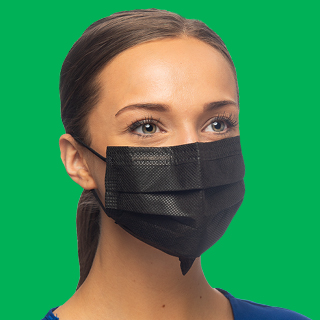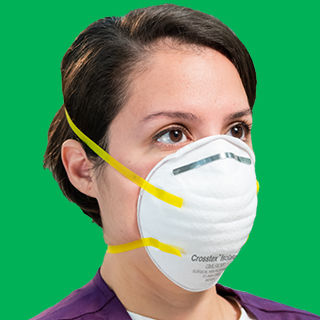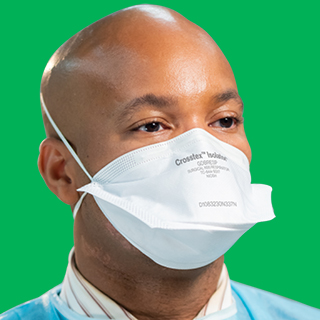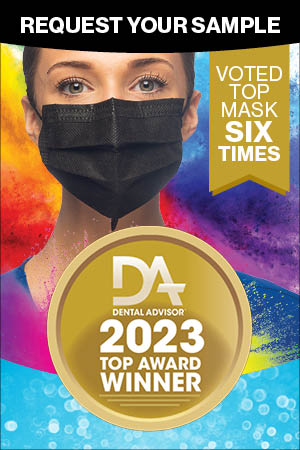Blog
Masks & Respirators: Understanding Your Options

Guidelines, best practices, and options available
Now that the CDC aggregates and reports COVID-related hospitalizations instead of COVID transmissions, dental professionals could be at risk. By the time a dental practice is alerted to a COVID outbreak in their area, transmissions could already be at concerning levels.
They still need to have best-practice protocols in place should emergencies arise, such as another COVID or viral pandemic outbreak. For example, the CDC and the World Health Organization (WHO) are tracking the emergence of a new, extremely transmissible strain of COVID. This predicates the need to keep a greater supply of surgical masks and respirators in the event of an emergency.
Dental practices should also consider the need for documented and flexible protocols related to flu and respiratory disease season. This could include more stringent screening of patients, use of masks by all staff members during “flu season,” as well as using respirators during aerosol-generating procedures with all patients.
The good news: practices have more options. Now is a good time to review the types of masks and respirators available for use in dental settings and when to choose each option.
Surgical Masks

Prior to the pandemic, surgical masks were worn primarily for source control and to provide protection against spray and aerosols. While those safety benefits continue to be important, the pandemic has raised awareness for the protection it can provide the wearer as well. Not all surgical masks are the same, however, and they may offer wearers varying degrees of protection from the environment. Most are not designed and manufactured to form a tight seal between the edges of the mask and the wearer’s face. However, Crosstex™ Masks featuring Secure Fit™ Technology do provide flexible aluminum nose and chin strips to help minimize gaps around any face shape, providing enhanced performance compared with traditional surgical masks.
Surgical masks also vary in the level of bacterial and particulate filtration provided and the fluid resistance they offer. The standards organization ASTM International developed the universally recognized testing and requirements rating scale that categorizes a surgical mask’s performance level
- ASTM Level 1 masks, such as the Crosstex™ Isofluid™ Surgical Masks,offer a bacterial and particulate filtration efficiency of 95% or greater and light fluid protection with resistance to penetration by synthetic blood of at least 80 mmHg. Level 1 surgical masks are ideal for procedures that produce a light amount of fluid, spray, and/or aerosols, such as patient exams, impressions, and orthodontics.
- ASTM Level 2 masks, such as the Crosstex™ Procedural Surgical Masks, offer a bacterial and particulate efficiency of 98% or greater and moderate fluid protection with resistance to penetration by synthetic blood of at least 120 mmHg. Level 2 surgical masks can be worn during limited oral surgery, endodontics, prophylaxis, restoratives, sealants, and other procedures that generate moderate amounts of fluid, spray, and/or aerosols.
- ASTM Level 3 masks, such as the Crosstex™ Ultra Surgical Masks, offer a bacterial and particulate efficiency of 98% or greater and high fluid protection with resistance to penetration of synthetic blood of at least 160 mmHg. Level 3 surgical masks are ideal for procedures that generate moderate or high amounts of fluid, spray, and/or aerosols, including complex oral surgery, crown preparation, implant placement, periodontal surgery, and the use of ultrasonic scalers.
When selecting from the different levels of surgical masks, keep in mind that every procedure is unique. Use clinical judgment to determine the appropriate protection based on the length of the procedure, the amount of fluid aerosol, and practice protocols.
Surgical N95 Respirators
The FDA defines an N95 respirator as “a respiratory protective device designed to achieve a very close facial fit and very efficient filtration of airborne particles.” The critical feature of an N95 respirator is the tight seal it forms around the nose and mouth, delivering the most respiratory protection possible. The National Institute for Occupational Safety and Health sets specific standards that manufacturers must comply with and tests respirators before awarding the N95 designation.

There are two kinds of N95 respirators: standard N95 respirators used primarily in industrial settings and surgical N95 respirators designed for use in health care settings. Like surgical masks, surgical N95 respirators can come in many shapes and constructions, from molded/cone styles to flat-fold styles. While the former styles are heavily utilized in industrial settings, the latter are popular in health care settings because of their enhanced comfort. Regardless of application or design, nearly all disposable N95 respirator styles incorporate dual headbands that allow for the mask to be adjusted to fit close to the face and eliminate gaps.
Wearing just any N95 respirator is generally not enough. Most importantly, a style should be chosen that allows the user to pass a fit test, a measurable way to determine proper fit under a set of predetermined conditions. For this reason and because of the diversity in user face shapes and sizes, it’s always a good idea for an office to have a couple of options on hand during fit testing.
To be cleared by the FDA as a surgical N95 respirator, a respirator must offer a particulate efficiency of 99.9% at 3 microns and a particulate filtration efficiency of 99.9% at 0.1 microns and be fluid-resistant.
- The Crosstex™ Isolator™ Plus N95 Surgical Respiratorhas demonstrated resistance to penetration by synthetic blood at pressures of at least 160 mmHg It’s flat fold style resembles and feels more like a surgical mask, which many clinicians may find more comfortable.
- The Crosstex™ Isolator™ Molded Surgical N95 Respirator offers a durable, collapse-resistant double-shell design that offers fluid resistant to penetration by synthetic blood at a minimum of 120mm/Hg. Wearers with wider/larger faces may find this traditional respirator style a better fit.
- The Crosstex™ Isolator™ Duckbill Surgical N95 Respiratorhas a flat-fold, duckbill design with a malleable nose piece and soft inner lining for excellent filtration, fit, and comfort. It offers resistance to penetration by synthetic flood at a pressure of at least 120 mmHg. This mask is perfect for anyone who finds surgical N95 respirators feel too close to the nose and mouth or make breathing difficult. The duckbill shape creates space between the wearer’s mouth and nose and the respirator itself.

Our duckbill style has been tested and shown to comply with the ASTM F3407 Respirator Fit Capability voluntary standard. This means it has been shown to properly fit the majority of the most common head and face sizes and shapes and may be a good solution for practices attempting to standardize on one type of respirator.
Note that as per OSHA standards, if the use of a respirator is necessary to protect the health of employees and required by the employer, the employer must establish and implement a written respiratory protection program. Additionally, under these circumstances, dental personnel must be medically cleared for respirator use prior to use and must undergo fit testing before gaining clearance to use specific respirator models. An additional fit test is required if a new respirator model is employed or whenever the employee reports, or the employer makes visual observations of, changes in the employee’s physical condition that could affect respirator fit.
Added Features to Look for in Masks and Respirators
Just because two models of a mask share the same ASTM level, it does not mean they are equal in quality. Certain features can help make masks more comfortable for wearers or improve their performance (and, therefore, boost patient and practitioner safety).
Some surgical mask features to look for include:
- Secure Fit™-Technology, exclusive to Crosstex ASTM-rated masks. Secure Fit Technology’s patented design features flexible aluminum nose and chin strips for a customized fit that eliminates dangerous gaps around any face shape. Independent laboratory testing has confirmed that Secure Fit Technology offers superior protection when compared to standard earloop masks.1 2
- FogFree™masks include a strip on the inner layer that prevents glasses and eye protection from fogging up and obscuring the vision of hygienists and dentists. Crosstex ASTM Level 1 and 3 masks can be purchased with the FogFree feature.
- Sensitive masks. Some masks include soft, ink and dye-free inner layers that may offer enhanced comfort for users.
- Color options. Colors can do more than make masks look nice or complement your practice’s color scheme. Color cues can help dental professionals quickly differentiate between ASTM levels, which increases efficiency and aids with compliance – especially in larger practices.
The risk of COVID infection may have diminished, but other diseases, ranging from the common cold to the flu, are still out there. By stocking your dental practice with high-quality, compliant masks and respirators, you can do your part to keep your patients, colleagues, and community safe.
12018. Reducing Leakage of Surgical Masks/J. Samuel, G.C. Smaldone, Stony Brook Medicine [Poster], ATS 2018, May 21, 2018, San Diego, CA.
2Patel RB, Skaria SD, Mansour MM, Smaldone GC. Respiratory source control using a surgical mask: An in vitro study (published correction appears in J Occup Environ Hyg. 2022 Jun;19(6):409]. J Occup Environ Hyg. 2016;13(7):569-576. doi:10.1080/15459624.2015.1043050.


